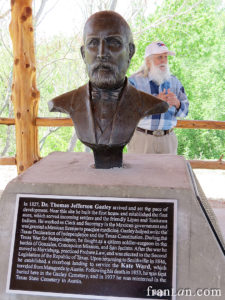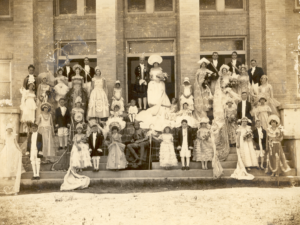
Dr. Thomas J. Gazley.
History is an elevated art form in Smithville. Public art around town also puts history into context.
The swallowtail sculpture at the Gazebo Park is a memorial of a tragic train explosion in 1908. A bust of one of the town’s founders, Dr. Thomas J. Gazley, is on display at Independence Park.
1827 to 1853: The Beginning
In 1827, Dr. Thomas Jefferson Gazley arrived and set the pace of development. Near this site he built the first house and established the first store, which served incoming settlers and the friendly Lipan and Tonkawa Indians. He worked as Clerk and Secretary in the Mexican government and was granted a Mexican license to practice medicine. Gazley helped write the Texas Declaration of Independence and the Texas Constitution. During the Texas War for Independence, he fought as a citizen soldier-surgeon in the battles of Gonzales, Concepcion Mission, and San Jacinto. After the war he moved to Harrisburg, practiced Probate Law, and was elected to the Second Legislature of the Republic of Texas. Upon returning to Smithville in 1846, he established a riverboat landing to service the Kate Ward, which traveled from Matagorda to Austin. Following his death in 1853, he was first buried here in the Gazley Cemetery, and in 1937 he was reinterred in the Texas State Cemetery in Austin.
1853 to 1887: Development before the Railroad
William Smith’s family arrived several years after Dr. Gazley. They owned a store and were early influences on the area, including the informal naming of Smithville. Later, that name was defended by a legendary coin toss with the Burlesons. In 1867, a post office was established—and still stands to this day thanks to periodic renovations and major repairs—the last in 2009. About seventeen families lived on the south bank of the Colorado River, while successful entrepreneur John Fawcett and admired statesman Thomas Hardeman lived west of town. Local businessman Murray Burleson learned of the approach of the Taylor, Bastrop, and Houston railroad, and worked with several partners to purchase land tracts in the Gazley and Loomis Surveys. A new town located adjacent to the railroad tracks was thereby platted and those seventeen families moved their homesteads from the Colorado River site to the Railroad location about two miles west. By negotiation and a gift of land, Burleson persuaded the railroad to erect a Terminus (a depot facility) at the new town site, and the TB&H steamed through in 1887. Almost overnight, the town flourished with new railroad workers, followed by commerce and the service industries needed to support the growing population.

Play at Central School in the early 1900s
1887 to 1911: Railroad Boom and Migration
The 1890, Smithville Census counted 616 residents. The Missouri, Kansas & Texas took over the TB&H Railroad in 1891. In 1894, the MK&T established central shops in Smithville, giving rise to growth that resulted in Smithville becoming the largest city in Bastrop County for nearly fifty years. Soon the burgeoning population created markets for homes, stores, and other necessities. Numerous businessmen made valuable contributions to Smithville as it grew from a frontier village to a town. The Hill family moved retail marketing here and established the first bank. The need for infrastructure like electrical and water systems attracted the Buescher brothers to establish the first utilities. Partnerships of prominent, able families involved in land-based activities united the Bueschers, Powells, Cooks, Eaglestons, Turneys, Rabbs, Buntes and others to establish cotton gins, general stores, drugstores, lumber and brick yards and to develop churches and fraternal organizations such as the Masons and the Oddfellows. In 1889, the neighboring Presbyterian Church (est. 1875) moved into town. Also established were: the Methodists (1888), the Baptists (1895) and the Catholics and Disciples of Christ (1896). This thriving community was officially incorporated as the City of Smithville in March 1895 with an estimated 2,500 residents. City leaders recognized the importance of education by creating the Smithville School District at the same time.
Museums
- Smithville Heritage Museum
602 Main
Also known as the Heritage House, this museum tells the history of Smithville. It is maintained by the Smithville Heritage Society.
- James H. Long Railroad Museum
100 NE 1st St.
This museum showcases the history of the Katy Railroad, highly significant to our town’s turn-of-the-century past.
- West End Park Museum
242 SH 95
From the late 1800s through the 1960s, the West End Park Club in Smithville’s South Side provided one of the last Texas stops on the Chitlin’ Circuit—bars and cafés considered “safe and welcoming” for African-American musicians especially during segregation when larger, whiter venues may have been intimidating or dangerous. B.B. King, Roosevelt Thomas Williams (a.k.a. the “Grey Ghost” born in a neighboring city), Lightnin’ Hopkins, T-Bone Walker, Joe Tex, and Etta James were among the best-known headliners. Local trumpeter Hannibal Lokumbe played there during its last days, and remembers growing up one block away from this amazing center of talent, peeking over the fence to watch these infamous kings and queens of blues and jazz. The baseball field in the Park adjoining the Club was also used for Negro Baseball League games, and great athletes like Satchel Paige and Josh Gibson played in Smithville regularly; club owner, I.T. Harper, used to pitch for the Kansas City Monarchs, and would book baseball players for exhibition games against the Smithville Team. In the mid-1950s, the infamous Satchel Paige found himself in a pitching duel against Harper that Paige eventually won 2-1 in extra innings. In 2016, the West End Park Marker was unveiled to a crowd of over 1,000 in the third Blues Review Festival to be coordinated at that site since 2011; the Blues Review is intended to be an annual fundraiser for the West End Park Museum housed in the Clubhouse building at that site.
https://www.facebook.com/SmithvilleHeritageSociety/

